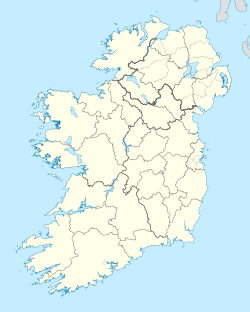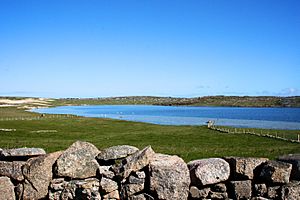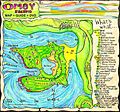Omey Island facts for kids
|
Native name:
Iomaidh
|
|
|---|---|
| Geography | |
| Location | Atlantic Ocean |
| Coordinates | 53°32′07″N 10°09′27″W / 53.53528°N 10.15750°W |
| Type | tidal island |
| Administration | |
| Province | Connacht |
| County | Galway |
| Demographics | |
| Population | 0 |
Omey Island (which is called Iomaidh in Irish) is a special kind of island called a tidal island. It's located near Claddaghduff on the western edge of Connemara in County Galway, Ireland.
From the mainland, Omey Island can be hard to spot because it blends in. You can actually drive or walk across a big sandy beach to reach the island. Just follow the arrow signs! When the tide is high, the water gets deep enough to cover a car, so you need to know the tide times to visit safely.
Contents
History of Omey Island
Ancient Monasteries and Saints
In the early 1990s, a team of archaeologists from University College Dublin started studying the island's old religious sites. Omey Island has long been known as the place where a monastery and settlement were founded by St. Feichin. In fact, the island's Irish name, Iomaidh Feichín, means "Feichín's bed or seat."
The archaeologists' digs helped us learn new things about early Christianity in Ireland. They even found one of the few known burials of a woman inside a monastery's burial ground. Experts believe this site dates back to the early 6th century.
Omey Island is still a place where people honor Saint Feichin today. There's a Holy Well on the western side and other important religious spots. You can also see the ruins of a medieval church. Most of its huge stones are still there, even after being buried in sand for hundreds of years. A local priest and people from the area dug them up in the past.
St. Feichin is said to have started many communities like this across western Ireland. He is seen as one of the most important early founders of Ireland's rich Christian history.
Life in Later Times
In the early 1500s, the O'Tooles from Leinster came to live on Omey Island. They were protected by the O'Flaherty family. Later, during the Cromwellian settlements, the Browns and D'Arcys took over. By the early 1800s, parts of Omey belonged to the Martins of Ballynahinch and the D'Arcys of Clifden.
John MacNeice, a bishop from the Church of Ireland, was born and grew up on Omey. He was known for disagreeing with the Ulster Covenant.
In the late 1800s, a writer named Bernard Henry Becker visited Omey Island. He wrote about how the island was once famous for growing potatoes. He mentioned that the wind was so strong, people were afraid to dig up the ground because it would blow the sand away and leave the potatoes bare!
Interesting Places to Visit
You can find "shell middens" in several places on the island. These are ancient piles of shells, like leftovers from meals eaten long ago. Some of these shell piles have been tested and are about 500 to 1000 years old.
The ruins of Teampaill Feichin, the medieval church, stand where St. Feichin's abbey was believed to be. It was dug out of the sand in 1981. Close by, there's a Holy Well with a small shrine around it.
People of Omey Island
The number of people living on Omey Island has dropped a lot. In the early 1800s, hundreds of people lived there. The local school, which opened in 1883, closed in 1973. By 1988, only three families were left.
For over 30 years, the only person living on the island full-time was Pascal Whelan, who used to be a stuntman and wrestler. The Irish poet Richard Murphy also lived on Omey Island for a while. He built a unique eight-sided house there, which you can still see today.
In 2003, an Irish artist named Sean Corcoran reported seeing a strange creature in the lake. He described it as looking like a Dobhar-chú (which means "Master Otter" in Irish folklore).
There is a graveyard on the island called Ula Bhreandain that is still used today.
The beach on Omey Island is also famous for the annual Omey Races. This horse racing event happens on the sand in late summer, usually in July or August. It was started again in 2001.
Population Changes Over Time
The table below shows how the population of Omey Island has changed over many years.
The last person who lived on the island all the time, Pascal Whelan, passed away in February 2017 when he was 75 years old.
| Historical population | ||||||||||||||||||||||||||||||||||||||||||||||||||||||||||||||||||||||||||||||||||||||
|---|---|---|---|---|---|---|---|---|---|---|---|---|---|---|---|---|---|---|---|---|---|---|---|---|---|---|---|---|---|---|---|---|---|---|---|---|---|---|---|---|---|---|---|---|---|---|---|---|---|---|---|---|---|---|---|---|---|---|---|---|---|---|---|---|---|---|---|---|---|---|---|---|---|---|---|---|---|---|---|---|---|---|---|---|---|---|
|
|
|
||||||||||||||||||||||||||||||||||||||||||||||||||||||||||||||||||||||||||||||||||||
| Source: | ||||||||||||||||||||||||||||||||||||||||||||||||||||||||||||||||||||||||||||||||||||||
Images for kids
See also
 In Spanish: Isla Omey para niños
In Spanish: Isla Omey para niños





